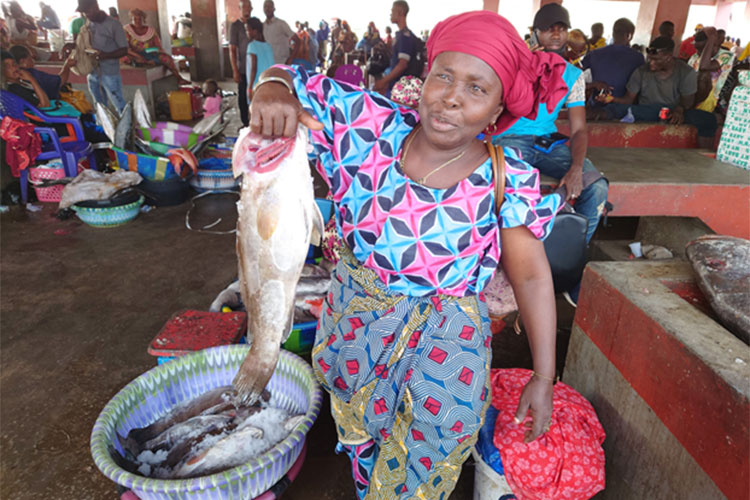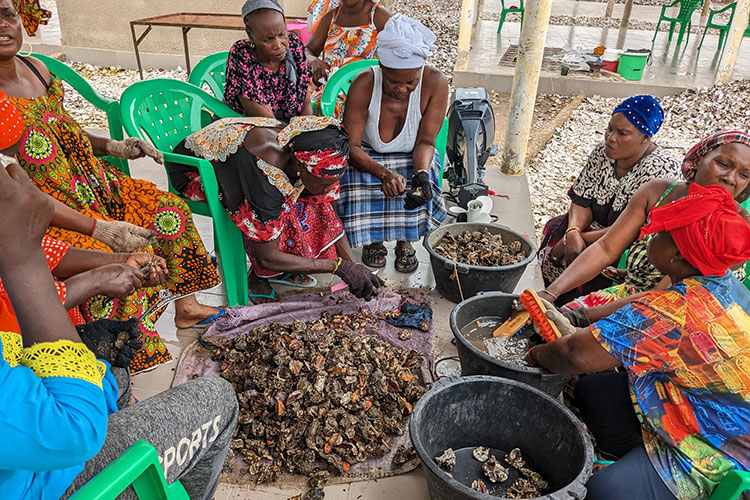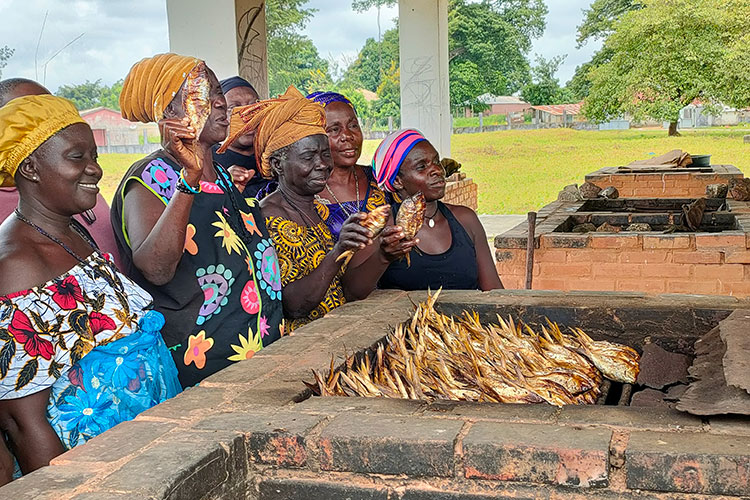3.2.1 Improving the value-added fisheries products
Adding value to small catches and selling them at a high price can maintain and improve the livelihoods of fishermen while reducing the burden on fishery resources. This section describes the value-adding of fishery products that enable the stabilisation of fishermen’s businesses when catches are limited for sustainable resource management.
- Identify challenges and target activities to undertake
- Develop and implement a training plan
- Implement measures to improve value
Identify challenges and target activities to undertake.
With the help of central and local governments, fisheries resource management organisations identify the strengths, weaknesses, threats, and opportunities of actors in the fisheries value chain, such as fishermen, fish traders, processors, and exporters of fishery products, and identify the challenges they face in controlling the quality of fishery products, including maintaining freshness. Then, activities will be narrowed down to overcome the issues identified and improve the added value of marine products.
For example, in the case of setting a closed season for shrimp, it is possible to limit fishing effort and improve the added value of the resource by accurately understanding the current situation where the unit landing price changes according to the setting of the closed season, ensuring the sustainability of the resource, and determining when the open season would provide the highest commercial value of the resource. Other similar effects can be achieved by planning shipments and improving the freshness and quality of the fish. Central and local governments support effective activities by sharing relevant information with organisations.
22. Opening date for the shrimp fishery, which determines the added value of shrimp
In the Fatick region of Senegal, an order regulating shrimp fishing has been in force since the 1990s. It sets the annual opening and closing dates for shrimp fishing. The peak season is from September to December, with a peak in October. This is because in this region, which is located in the savannah climate zone with little rainfall, shrimp grow larger as rainfall increases and the salinity of the habitat decreases and the high-value jumbo shrimp catch becomes peak season. The timing of the shrimp fishery is therefore an important factor in the production of high-value jumbo shrimp.
Develop and implement a training plan.
Resource management organisations review the content and participants of technical training as necessary and develop a training plan and a list of materials and equipment needed for training and practice. They share this with central and local government officials and ask for any necessary support. Central and local government officials review and budget for the training plan and equipment needs. Resource management organisations deliver planned training and work with central and local government officials to obtain equipment and materials.
Implementation measures to improve added value
The following are some ways in which added value can be improved at each stage of the fisheries value chain.
<Improvements in on-board catch processing>
1) Increase added value by improving on-board processing
Increase the added value of fishery products by improving on-board processing at the time of capture, thereby preserving the freshness of the catch and maintaining and managing the quality of fishery products required by the market. Target fishermen will be provided with information on how to handle marine products on board and on hygiene and quality control and the necessary awareness-raising activities will be conducted. An example is the use of ice and insulated boxes onboard boats to keep the catch fresh.
23. Increasing the added value of the octopus by improving on-board processing
In Senegal, octopuses are caught with lines and artificial bait. Previously, once caught, octopuses were beaten against the hull of the boat to weaken them and then left on board, exposed to direct sunlight. They were not iced and were left in stagnant water at the bottom of the boat. Octopuses immersed in stagnant water absorb water, causing them to swell and deteriorate in quality. There was also a widespread practice of fish traders allowing octopus to absorb water before shipping to increase the weight of their products. JICA's PROCOVAL project from 2014 to 2017 aimed to improve on-board processing of octopus catches, encourage fishermen to export high-quality octopuses to foreign markets where prices are higher, and strengthen the management of the octopus resource.
<Quality improvement at landing-site facilities>
1) Raise awareness of hygiene and quality control at landing sites
Fisheries resource management organisations work with administrations to train relevant actors, such as fishermen, fishmongers, and fishing companies, in hygiene and quality control at landings. A system of management, operation, and maintenance of the landing site facilities (such as facility manager, financial manager, environmental manager, safety manager, and auditor) led by the resident leaders of the target area must be determined. The members of the landing site management should be drawn from a variety of fields to reflect the opinions of the stakeholders who use the facilities.
24. Increasing value-added by improving quality control and hygiene at landing sites
By improving the quality and distribution of fish at the landing site, the freshness of fish can be preserved and they can be distributed to national and international markets that appreciate the added value, which benefits all parties involved in the value chain, including fishers, fish traders, and fishing companies. If all parties can improve their profits, they will be able to maintain their profits while reducing catches owing to fisheries resource management restrictions. With this in mind, the PROCOVAL project conducted pilot activities to improve quality and hygiene at the landing sites in Mbour and Joal.
2) Provide facilities for quality improvement and establish a management and operating system
Those responsible for the management and operation of landing facilities work with the administrations to determine the amount of ice needed, using historical landing data and other information, and to draw up a list of the equipment needed, such as an ice factory, ice storage machine, and insulated boxes. At the same time, a list of materials and equipment needed for the hygienic management of landing facilities (such as fences, hanging nets, and walls to prevent livestock, insects, and birds from entering the landing facilities) will be developed and negotiated with the government, donors, and private companies for their acquisition. Revenues and expenses of landing facilities will be calculated, a facility management and operation plan will be developed, and equipment such as ice plants and ice storage machines will be deployed to ensure a continuous supply of ice. Furthermore, it is necessary to improve the hygiene and quality of landed fishery products and establish a system for issuing appropriate landing certificates for fishery products.
25. Increasing the added value of fishery products by developing certified landing facilities
There are two certified landing facilities in the department of Mbour in Senegal but they are not sufficiently hygienic. Many fishing villages do not have landing facilities and when fishery products land in these villages for export to the EU, they must be transported to certified landing facilities in Mbour and Joal and must obtain landing certificates. Therefore, it was necessary to increase the number of certified landing facilities, improve the quality of the products landed, and reduce the time and trouble required to issue landing certificates.
3) Promote continuous and stable management and operational services
The personnel responsible for the management and operation and the staff of the landing facilities promote the following tasks:
- ・Regularly monitor the proper management of landing facilities, fish processing operations, and certification procedures
- ・Issue landing certificates on the basis of monitoring results and appropriate procedures
- ・Analyse landing statistics to reflect in facility management and operational planning
- ・Audit the management and operation of the facilities and report on income and expenditure


<Improving value addition in traditional fishery processing by women.
1) Review market needs and areas for product improvement
Fisheries resource management organisations, in collaboration with administrations, conduct interviews with fishermen’s leaders, processors, and women’s groups to identify market needs and areas for product improvement and identify problems related to market trends, hygiene control, and quality maintenance.
2) Raise awareness of the target group
The fisheries resource management organisations, in collaboration with administrations, select or create processors and women’s groups for the activities and sensitise these groups to value-adding and quality control of fishery products contributing to post-harvest improvement.
3) Produce high value-added processed products and ensure quality control
The processor and women’s groups in charge of the activities examine problems in the current processing of fishery products and develop measures to remedy them and increase added value. In accordance with these measures, highly value-added processed products will be produced and quality control will be thoroughly implemented. The concept of improved processed products is explained to fish traders and other buyers of processed products and a fixed price is negotiated.


Value-added sales strategy
Several attempts have been made to improve added value in the shipping and marketing of processed fishery products. Some of these attempts are as follows.
⚫︎ Introduction to packaged sales: Many women’s groups are artisanal processors and often sell their products by the kilo. The processed products produced by women can be packaged, labelled, and sold to add value.
⚫︎ Use of product labels: Labelled products can add value to the products through a higher quality image created by labelling, environmental considerations (e.g. eco-labelling), and ‘visibilisation’ of the producers through traceability. These initiatives encourage the practice of fisheries resource management and economic incentives for these activities.
⚫︎ Branding: The introduction of a label certification system allows the branding of fishery products to increase their value. In addition to using branding to increase the sense of quality, it is also possible to add fishery products’ value by indicating to consumers that they have met certain standards for environmental protection, such as consideration of the condition of the target resource and ecosystem, and compliance with fishery management.
26. Initiatives for introducing label certification schemes
Labels that support sustainable fishing and guarantee traceability are becoming increasingly common, especially in Europe. The obtaining and renewal of certification from a globally recognised label is quite challenging for Senegal due to expensive cost. It is therefore more sustainable to launch Senegal's own ecolabel to raise national and international awareness. The creation of Senegal's own labelling system will guarantee the quality of fishery products for the domestic and international (European and Asian) markets and will be recognised by the market and producers. To this end, JICA's PROCOVAL project implemented activities to support the introduction of a label certification system to stabilise the quality of fisheries products in the department of Mbour at a high level, motivating the people involved and promoting fisheries resource management activities.
26. Trial sales of labelled fisheries products
To obtain product marketing ratings and related information, JICA's PROCOVAL project conducted a trial sale of the ‘Beg Ellek’ label products of its partner company, IKAGEL. The results showed that, although Senegalese consumers showed some understanding of the quality-integrated label certification system, this understanding was not yet closely linked to their daily consumption behaviour.